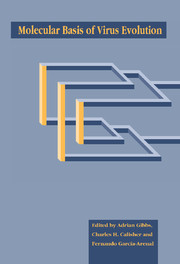Book contents
- Frontmatter
- Contents
- List of contributors
- Editors' preface
- Conference participants
- 1 Introduction and guide
- Part I The impact of viral diseases
- Part II Origins of viruses and their genes
- Part III Sources of virus variation
- 8 Molecular mechanisms of point mutations in RNA viruses
- 9 Recombination and its evolutionary effect on viruses with RNA genomes
- Part IV Molecular interactions of viruses and their hosts
- Part V Viruses, hosts and populations
- Part VI Case studies of viral taxa; their systematics and evolution
- Part VII Techniques for viral systematics
- Index
8 - Molecular mechanisms of point mutations in RNA viruses
Published online by Cambridge University Press: 04 May 2010
- Frontmatter
- Contents
- List of contributors
- Editors' preface
- Conference participants
- 1 Introduction and guide
- Part I The impact of viral diseases
- Part II Origins of viruses and their genes
- Part III Sources of virus variation
- 8 Molecular mechanisms of point mutations in RNA viruses
- 9 Recombination and its evolutionary effect on viruses with RNA genomes
- Part IV Molecular interactions of viruses and their hosts
- Part V Viruses, hosts and populations
- Part VI Case studies of viral taxa; their systematics and evolution
- Part VII Techniques for viral systematics
- Index
Summary
Introduction
Analyses of populations of viruses with RNA genomes find a large amount of variability that results from re-assortment of genome segments of those viruses that have multipartite genomes, recombination events, point mutations and small deletions or insertions. The reverse transcriptases (RT) and the RNA-dependent RNA polymerases (RdRp) cause the last three types of change. These polymerases are error-prone owing to their intrinsic low level of fidelity and to their lack of correction mechanisms. In addition, host factors can also be responsible for certain mutations.
This chapter deals with point mutations; indeed, point mutations represent the main source of diversity occurring during replication of the genome of RNA viruses. It attempts to briefly survey 1) the genetic variation in virus populations, 2) the methods used to determine mutation rates and frequencies, 3) the estimates of such mutation rates and frequencies obtained in vivo and of error rates obtained in vitro for the most studied viruses, and 4) our present knowledge concerning the mechanisms of point mutations. It does not deal with recombination and re-assortment; the reader is referred to other chapters of this book for information on these topics.
Genetic variation in virus populations
Most RNA virus infections correspond to heterogeneous virus populations that can be referred to as quasi-species; this term describes complex distributions of replicating molecules subject to mutation and competitive selection (Domingo et al., 1992). If RNA virus populations are maintained at constant selective pressures, genomic variability is high, but a stable distribution is reached that usually undergoes minimal changes (Domingo et al., 1978).
- Type
- Chapter
- Information
- Molecular Basis of Virus Evolution , pp. 105 - 118Publisher: Cambridge University PressPrint publication year: 1995
- 6
- Cited by



